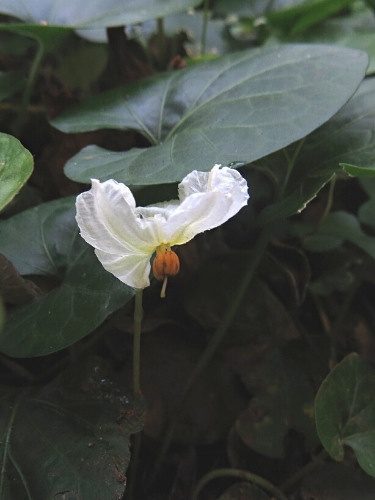The gingerleaf (Lycianthes asarifolia) is an herbaceous, sprawling, fruit-bearing, perennial plant with distinct heart-shaped leaves. It is native to Brazil and can be found in forested regions within the biomes of Cerrado, Pantanal, Atlantic Forest, and the Amazon Rainforest. Unfortunately, it is threatened by extinction due to deforestation in Brazilian forests.
Reaching about 12 inches (30 cm) in height, it features long branches that emit adventitious roots, which penetrate the soil to form storage structures like tubers. Its leaves are dark green, whole, simple, leathery, broad, heart-shaped, thick, and with prominent veins on the upper surface. These leaves are supported by long petioles that can reach up to 3.5 inches (9 cm).
The flowers appear almost year-round, solitary, occasional, small, white with a yellow center, and with petals resembling tissue paper, attached to a long peduncle. Because they emerge beneath the foliage, the flowers are rarely noticed, offering secondary ornamental value. Fruits, on the other hand, appear in summer and autumn. They are small, round, orange when ripe, and contain kidney-shaped seeds.
With dense foliage, the gingerleaf is perfect as ground cover, spreading rapidly and adding volume and texture to flowerbeds. This makes it stand out from common grass, especially in semi-shaded areas where grass struggles. Additionally, due to its rarity, it brings a unique and exclusive character to landscaping projects. However, it’s not tolerant of foot traffic. In the garden, combine large masses of gingerleaf with others composed of plants with different sizes, colors, and textures, allowing them to complement and enhance each other.
Another appealing use is in vertical garden projects, as ground cover. As a bonus, this hardy plant will produce various sweet fruits resembling Physalis (Physalis sp), which can be consumed fresh or turned into juices and jams. Maintenance is straightforward, involving semi-annual fertilization with decomposed organic matter and mulching, thus simulating forest soil for optimal development.
It should be cultivated in partial shade or full sun, in soil rich in organic matter and well-draining. It does not tolerate the frosts common in subtropical climates, but in this case, it can be grown under the canopy of trees for protection. Regarding watering, the gingerleaf requires consistently moist and cool soil, so regular irrigation is recommended in areas where these conditions cannot be naturally maintained.
Fertilize during spring and autumn, preferably using organic fertilizers like compost, well-rotted manure, bone meal, etc. Remember to add mulch such as pine bark, dry leaves, or straw to keep the soil consistently moist and cool. Propagation of the gingerleaf can be done through seeds or by dividing rooted branches in spring and summer. Seeds usually start to germinate about 30 days after planting.


